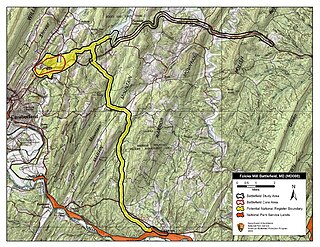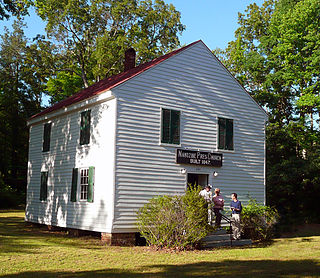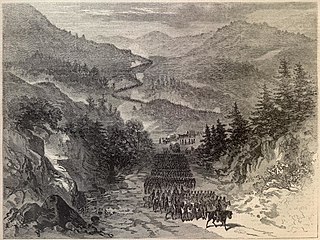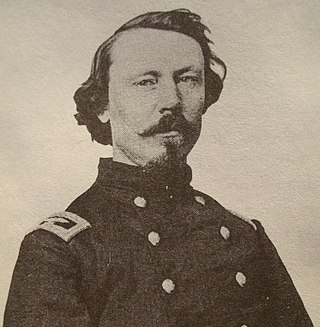
The Battle of Brice's Cross Roads, also known as the Battle of Tishomingo Creek or the Battle of Guntown, was fought on Friday, June 10, 1864, near Baldwyn, Mississippi, then part of the Confederate States of America. A Federal expedition from Memphis, Tennessee, of 4,800 infantry and 3,300 cavalry, under the command of Brigadier-General Samuel D. Sturgis, was defeated by a Confederate force of 3,500 cavalry under the command of Major-General Nathan B. Forrest. The battle was a victory for the Confederates. Forrest inflicted heavy casualties on the Federal force and captured more than 1,600 prisoners of war, 18 artillery pieces, and wagons loaded with supplies. Once Sturgis reached Memphis, he asked to be relieved of his command.

The Battle of Dranesville was a small battle during the American Civil War that took place between Confederate forces under Brigadier General J. E. B. Stuart and Union forces under Brigadier General Edward O. C. Ord on December 20, 1861, in Fairfax County, Virginia, as part of Major General George B. McClellan's operations in northern Virginia. The two forces on similar winter time patrols encountered and engaged one another in the crossroads village of Dranesville. The battle resulted in a Union victory.
The Battle of McDowell, also known as the Battle of Sitlington's Hill, was fought on May 8, 1862, near McDowell, Virginia, as part of Confederate Major General Stonewall Jackson's 1862 Shenandoah Valley campaign during the American Civil War. After suffering a tactical defeat at the First Battle of Kernstown, Jackson withdrew to the southern Shenandoah Valley. Union forces commanded by Brigadier Generals Robert Milroy and Robert C. Schenck were advancing from what is now West Virginia towards the Shenandoah Valley. After being reinforced by troops commanded by Brigadier General Edward Johnson, Jackson advanced towards Milroy and Schenck's encampment at McDowell. Jackson quickly took the prominent heights of Sitlington's Hill, and Union attempts to recapture the hill failed. The Union forces retreated that night, and Jackson pursued, only to return to McDowell on 13 May. After McDowell, Jackson defeated Union forces at several other battles during his Valley campaign.

The Battle of Folck's Mill, also known as the Battle of Cumberland, was a small cavalry engagement, fought August 1, 1864, in northern Maryland, as part of the Valley Campaigns of 1864 during the American Civil War.
The Battle of Waynesboro was fought on March 2, 1865, at Waynesboro in Augusta County, Virginia, during the American Civil War. It was a complete victory for Brig. Gen. George Armstrong Custer and the final battle for Confederate Lt. Gen. Jubal Early, whose force was destroyed.
The Third Battle of Murfreesboro, also known as Wilkinson Pike or the Cedars, was fought December 5–7, 1864, in Rutherford County, Tennessee, as part of the Franklin-Nashville Campaign of the American Civil War.

The Appomattox campaign was a series of American Civil War battles fought March 29 – April 9, 1865, in Virginia that concluded with the surrender of Confederate General Robert E. Lee's Army of Northern Virginia to forces of the Union Army under the overall command of Lieutenant General Ulysses S. Grant, marking the effective end of the war.

The Battle of Big Black River Bridge was fought on May 17, 1863, as part of the Vicksburg Campaign of the American Civil War. During the American Civil War, the city of Vicksburg, Mississippi, was a key point on the Mississippi River. On April 30, 1863, a Union army commanded by Major General Ulysses S. Grant began crossing onto the east side of the Mississippi River. After defeating Confederate forces in several intermediate battles, Grant's army defeated Lieutenant General John C. Pemberton's Confederates at the decisive Battle of Champion Hill on May 16. One division of Pemberton's army, commanded by Major General William W. Loring, had become cut off from Pemberton's main body during the retreat from Champion Hill. Pemberton did not know of the location of Loring's division, and held a bridghead on the east side of the Big Black River on the morning of May 17 to cover Loring's anticipated withdrawal across the river.

The siege of Knoxville saw Lieutenant General James Longstreet's Confederate forces besiege the Union garrison of Knoxville, Tennessee, led by Major General Ambrose Burnside. When Major General William T. Sherman approached Knoxville with an overwhelming Union force, Longstreet ended the siege on December 4 and withdrew northeast. The siege was part of the Knoxville campaign of the American Civil War.

The Franklin–Nashville campaign, also known as Hood's Tennessee campaign, was a series of battles in the Western Theater, conducted from September 18 to December 27, 1864, in Alabama, Tennessee, and northwestern Georgia during the American Civil War.

The siege of Corinth was an American Civil War engagement lasting from April 29 to May 30, 1862, in Corinth, Mississippi. A collection of Union forces under the overall command of Major General Henry Halleck engaged in a month-long siege of the city, whose Confederate occupants were commanded by General P.G.T. Beauregard. The siege resulted in the capture of the town by Federal forces.

The Battle of Namozine Church was an engagement in Amelia County, Virginia, between Union Army and Confederate States Army forces that occurred on April 3, 1865, during the Appomattox Campaign of the American Civil War. The battle was the first engagement between units of General Robert E. Lee's Confederate Army of Northern Virginia after that army's evacuation of Petersburg and Richmond, Virginia, on April 2, 1865, and units of the Union Army under the immediate command of Maj. Gen. Philip Sheridan, who was still acting independently as commander of the Army of the Shenandoah, and under the overall direction of Union General-in-Chief Lt. Gen. Ulysses S. Grant. The forces immediately engaged in the battle were brigades of the cavalry division of Union Brig. Gen. and Brevet Maj. Gen. George Armstrong Custer, especially the brigade of Colonel and Brevet Brig. Gen. William Wells, and the Confederate rear guard cavalry brigades of Brig. Gen. William P. Roberts and Brig. Gen. Rufus Barringer and later in the engagement, Confederate infantry from the division of Maj. Gen. Bushrod Johnson.

The Carolinas campaign, also known as the campaign of the Carolinas, was the final campaign conducted by the Union Army against the Confederate Army in the Western Theater of the American Civil War. On January 1, Union Maj. Gen. William T. Sherman advanced north from Savannah, Georgia, through the Carolinas, with the intention of linking up with Union forces in Virginia. The campaign culminated in the defeat of Confederate Gen. Joseph E. Johnston's army at the Battle of Bentonville, and its unconditional surrender to Union forces on April 26, 1865. Coming just two weeks after the defeat of Robert E. Lee's army at the Battle of Appomattox Court House, it signaled that the war was effectively over.
The Meridian campaign or Meridian expedition took place from February 3 – March 6, 1864, from Vicksburg, Mississippi to Meridian, Mississippi, by the Union Army of the Tennessee, led by Maj. Gen. William Tecumseh Sherman. Sherman captured Meridian, Mississippi, inflicting heavy damage to it. The campaign is viewed by historians as a prelude to Sherman's March to the Sea in that a large swath of damage and destruction was inflicted on Central Mississippi as Sherman marched across the state and back.

Kenner Garrard was a brigadier general in the Union Army during the American Civil War. A member of one of Ohio's most prominent military families, he performed well at the Battle of Gettysburg, and then led a cavalry division in the army of Major General William T. Sherman during the Atlanta Campaign. He developed a reputation for personal bravery and was cited for gallantry at the Battle of Nashville as an infantry division commander.

The September 7–9, 1863 fall of the Cumberland Gap was a victory for Union forces under the command of Ambrose Burnside during his campaign for Knoxville. The bloodless engagement cost the Confederates 2,300 men captured and control of the Cumberland Gap.
The 5th Ohio Cavalry Regiment was a regiment of Union cavalry raised in seven counties in southwestern Ohio for service during the American Civil War. It primarily served in the Western Theater in several major campaigns of the Army of the Tennessee.

The Battle of Bentonville was fought in Johnston County, North Carolina, near the village of Bentonville, as part of the Western Theater of the American Civil War. It was the last battle between the armies of Union Maj. Gen. William T. Sherman and Confederate Gen. Joseph E. Johnston.

Patrick Emmet Burke was a lawyer, Missouri state legislator, and Civil War officer. He commanded the Western Sharpshooters Regiment and the 2nd Brigade, 2nd Division, XVI Corps, Army of the Tennessee.

The Second Battle of Pocotaligo, or Battle of Pocotaligo Bridge, or Battle of Yemassee, often referred to as simply the Battle of Pocotaligo, was a battle in the American Civil War on October 22, 1862 near Yemassee, South Carolina.
















